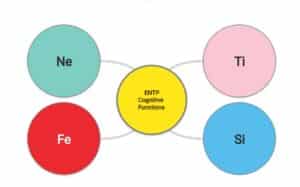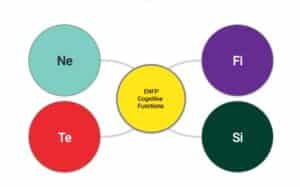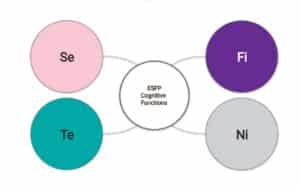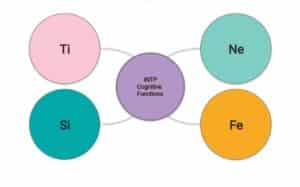Reading Time: 25 Minutes
So, you want to understand ESTJ Cognitive Functions? Great choice! If you’ve ever wondered why some people seem to have a natural knack for organizing, leading, and making sure everything runs like a well-oiled machine, you’re in the right place. ESTJs are like the CEOs of everyday life, using their cognitive functions to keep things efficient, practical, and on track. In this guide, we’ll break down what makes the ESTJ tick, from their primary strengths to the sneaky shadow functions that occasionally trip them up. Let’s get started—because, just like an ESTJ, we don’t waste time!
Overview of ESTJ’s Cognitive Functions
Alright, let’s break this down in a way that even your grandma would nod along with. If you’re an ESTJ, you’ve got four key cognitive functions buzzing around in your brain, driving how you think, act, and respond to the world. These functions are like the gears in a clock—each one has its role, and when they work together, things run smoothly. Let’s dig into each one, keeping it simple and easy to grasp.
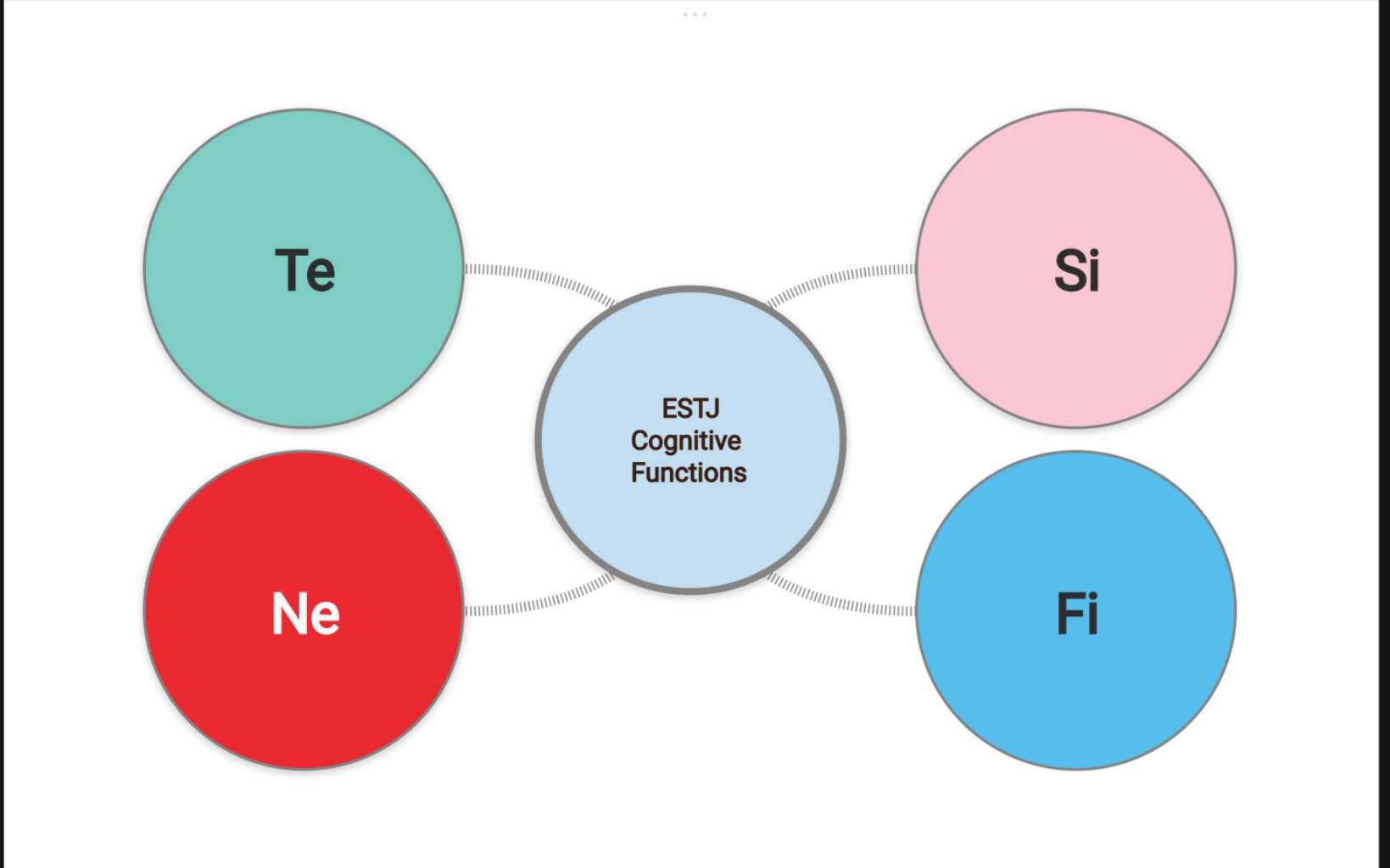
1. Dominant Function: Extraverted Thinking (Te)
First up, we’ve got Extraverted Thinking, or Te for short. If you’re an ESTJ, Te is like your brain’s CEO. It’s the boss, calling the shots and making sure everything runs like a well-oiled machine. Te loves efficiency, order, and logic. You’re the type who likes to get things done—no fuss, no frills. You see a problem, and your brain jumps straight into action mode, organizing everything into a neat plan. Imagine a general mapping out a battle strategy or a manager lining up tasks for the week. That’s you, in a nutshell.
Now, because you love structure, you’re probably the one who gets annoyed when things are disorganized or inefficient. You might find yourself stepping in to take control when others are floundering. And let’s be honest, you can be a bit of a stickler for rules and protocols. But hey, someone’s got to keep things on track, right? People might say you’re bossy, but in reality, you’re just making sure the train runs on time. Without Te, the world would be a chaotic mess of half-baked ideas and missed deadlines.
2. Auxiliary Function: Introverted Sensing (Si)
Next, let’s talk about your trusty sidekick: Introverted Sensing, or Si. While Te is out there managing the world, Si is like your memory bank. It’s the one that says, “Hey, we’ve been here before, and this is how it worked last time.” Si loves the familiar. It’s all about relying on past experiences, traditions, and the good old “tried and true” methods. If you’re an ESTJ, you probably have a strong sense of history—whether that’s family traditions, workplace protocols, or just knowing how things have always been done.
Si doesn’t like surprises. It’s the part of you that enjoys routines and consistency. You probably find comfort in knowing what to expect, and you might get a bit thrown off when things deviate from the norm. But this isn’t a bad thing! Si helps you stay grounded and reliable. While everyone else is chasing the next shiny new idea, you’re the one who remembers what actually works. This function pairs beautifully with Te, providing a solid foundation for all that efficient decision-making. It’s like having a map while navigating new territory—you’re not just wandering aimlessly; you’ve got a plan, and you’ve been here before.
3. Tertiary Function: Extraverted Intuition (Ne)
Now, here’s where things get interesting. Deep down, you’ve got a little spark of creativity, courtesy of Extraverted Intuition (Ne). This function isn’t as dominant in your life, but it’s there, like a wild card you can pull out when needed. Ne is all about possibilities, patterns, and what-ifs. It’s the part of you that occasionally thinks, “Hey, what if we tried this differently?”
If you’re an ESTJ, you might not tap into Ne as often, but when you do, it’s like a breath of fresh air. Suddenly, you’re open to new ideas and different approaches. Maybe you’ve got a project that’s starting to feel stale, and out of nowhere, you get a flash of inspiration to shake things up. That’s Ne at work. It’s not always comfortable for you because it can feel a bit like stepping into the unknown, but when balanced with your Te and Si, Ne can help you adapt and innovate without losing your footing.
4. Inferior Function: Introverted Feeling (Fi)
Finally, we’ve got your inferior function, Introverted Feeling (Fi). If Te is the CEO, Fi is like the quiet, introspective thinker who sits in the back, only speaking up when something really matters. Fi is all about personal values, emotions, and what feels right deep down. As an ESTJ, Fi can be tricky because it’s not your go-to function. You might struggle with expressing emotions or understanding why something feels off when it doesn’t align with your logical approach.
But don’t underestimate Fi. It’s the part of you that keeps everything from becoming too cold and calculated. It reminds you that not everything can be solved with logic alone—sometimes, you need to listen to your gut or consider how your decisions affect others on an emotional level. Fi might not always be front and center, but when it does show up, it helps you make decisions that are not just effective but also aligned with your personal values. Developing Fi can be a challenge, but it’s crucial for rounding out your personality and ensuring you’re not just a taskmaster but also a thoughtful, empathetic leader.
You Might Like To Read: ENTP Cognitive Functions (Ne, Ti, Fe, Si)- All 8 Functions Deep-dive Analysis
ESTJ Cognitive Function Dynamics
Alright, let’s dive into how these cognitive functions actually work together. Think of your mind like a well-organized factory, with each function playing a specific role on the production line. If you’re an ESTJ, you’ve got your Te (Extraverted Thinking) as the foreman, Si (Introverted Sensing) as the quality control officer, Ne (Extraverted Intuition) as the creative consultant, and Fi (Introverted Feeling) as the ethical advisor. When they all work together, it’s like a perfectly timed assembly line—each part contributes to the final product, which in this case, is you making decisions and interacting with the world.
Your dominant Te is always at the forefront, making sure everything gets done efficiently. It’s like the fast-paced boss, keeping everyone on their toes. Right behind it is Si, which provides the data and memories from the past—sort of like the person who always says, “Hey, this worked last time, let’s do it again.” Te listens because, let’s face it, why reinvent the wheel when you’ve already got a solid plan?
Now, Ne pops in occasionally with a fresh perspective, suggesting that maybe, just maybe, there’s a new way to approach things. Ne is like that one employee who isn’t afraid to think outside the box, but they’re also not the one in charge, so their ideas get filtered through the practical lens of Te and Si. Finally, Fi quietly chimes in when something doesn’t feel right. It’s like the moral compass, ensuring that what you’re doing aligns with your values, even if you don’t always give it the attention it deserves.
Sometimes, these functions don’t always see eye to eye. For instance, your Te might want to bulldoze through a decision because it makes sense logically, but Fi might throw a wrench in the works by making you feel uneasy about it. Or, Ne might suggest a wild idea, and Si might resist because it’s never been done before. These little disagreements are part of the dynamic, but when they’re balanced, they make you a well-rounded person—efficient yet considerate, traditional yet open to new ideas.
Practical Applications of Understanding ESTJ Cognitive Functions
So, what does all this mean in the real world? Knowing how your cognitive functions work can be a game-changer in several areas of your life, whether you’re at work, at home, or just hanging out with friends. Let’s break it down.
In the Workplace
At work, your Te is a powerhouse. You’re the one who takes charge, gets things done, and makes sure everyone stays on track. But here’s the thing—knowing how your other functions play into this can make you an even better leader. For example, when you tap into your Si, you don’t just lead; you lead with experience. You can say, “We’ve done it this way before, and it worked, so let’s stick to it.”
Your Ne might suggest tweaks to improve efficiency, and when you listen to it, you can come up with innovative solutions that still make sense. And don’t forget Fi! Even in a business setting, values matter. If you take the time to consider how your decisions impact others on a deeper level, you’ll earn respect and loyalty from your team.
In Relationships
When it comes to relationships, understanding your cognitive functions can help you navigate everything from family dinners to date nights. You might have a habit of organizing and leading, which is great—someone has to pick the restaurant, right? But remember, not everyone thinks like you. If your partner or friends don’t appreciate your Te’s efficiency, it might help to tap into Fi a bit more. Try asking yourself how they might feel about your decisions.
Ne can also be handy in relationships; it allows you to explore new activities and ideas together, keeping things fresh and exciting. And Si? Well, Si helps you remember important dates, traditions, and those little details that mean a lot to others. Don’t underestimate the power of remembering someone’s favorite dessert!
In Personal Growth
Lastly, let’s talk about how this knowledge can help you grow as a person. It’s easy to lean on your dominant Te because it’s comfortable and gets results. But personal growth often happens when you step out of your comfort zone. By consciously developing your Ne, you can become more open to new experiences and ideas, which can be incredibly rewarding.
Working on your Fi can help you become more in tune with your emotions and those of others, leading to deeper connections and a better understanding of yourself. And don’t forget about Si—it’s your safety net, reminding you of where you’ve been and helping you stay grounded as you explore new territory.
The 4 Shadow Functions of ESTJ
Let’s talk about the shadow side of being an ESTJ. Every personality type has shadow functions—these are like the mirror images of your main cognitive functions. They’re not as friendly or easy to work with, but they’re still part of you, lurking in the background. Think of them as the backseat drivers of your mind—they’re not in control, but they’ll pipe up at inconvenient times, usually causing a bit of chaos. For ESTJs, these shadow functions can be tricky because they’re the opposite of what you’re naturally good at.
1. Opposing Role: Introverted Thinking (Ti)
First up, we’ve got Introverted Thinking (Ti). If your Te is the efficient, no-nonsense boss, Ti is like the nitpicky analyst who questions everything. Ti loves to dive deep into the details, questioning logic and looking for internal consistency. For an ESTJ, this can feel uncomfortable because you prefer to make decisions quickly and move on.
But when Ti shows up, it can make you second-guess your actions or get stuck overthinking minor details. You might find yourself suddenly questioning whether your plan really makes sense or if there’s a flaw you didn’t consider. It’s like having a tiny critic in your head, poking holes in your ideas when you’d rather just get things done.
2. Critical Parent: Extraverted Sensing (Se)
Next, we have Extraverted Sensing (Se), which acts like the critical parent in your psyche. Se is all about living in the moment, focusing on what’s happening right here, right now. It’s the opposite of your Si, which prefers sticking to what’s familiar and reliable. When Se rears its head, you might feel an urge to be more spontaneous or take risks you’d normally avoid.
This can lead to feeling a bit out of control, like you’re being pushed to act impulsively against your better judgment. For example, you might suddenly feel like throwing caution to the wind and trying something completely new, only to regret it later. Se can be fun in small doses, but for an ESTJ, it often feels unsettling.
3. Trickster: Introverted Intuition (Ni)
Then there’s Introverted Intuition (Ni), the trickster of your shadow functions. Ni is all about deep, abstract insights and seeing the big picture in ways that are often mysterious and hard to explain. If you’re an ESTJ, Ni can mess with you by making you doubt your clear, straightforward thinking. It’s like suddenly having a hunch that doesn’t quite fit with the facts you usually rely on.
Ni might give you a gut feeling that something is off, even when everything seems to be going according to plan. This can be confusing because Ni doesn’t play by your usual rules of logic and order. It’s like trying to navigate a maze in the dark—you’re not sure where you’re going, and you’re not even sure if you should trust the path you’re on.
4. Demon: Extraverted Feeling (Fe)
Finally, we’ve got Extraverted Feeling (Fe), which is the demon function for ESTJs. Fe is all about understanding and managing group harmony, emotions, and social dynamics. For an ESTJ, who usually relies on Te’s logical approach, Fe can feel completely foreign. When it does come into play, it’s often in a negative way—maybe you suddenly worry too much about what others think, or you feel overwhelmed by emotions that you can’t quite handle.
Fe can make you feel vulnerable or out of control, which is the opposite of your usual strong, decisive self. It’s like being in a social situation where everyone else seems to be tuned in to each other’s feelings, and you’re just trying to figure out what’s going on. When Fe gets triggered, it can leave you feeling frustrated or isolated, as if you’re out of sync with everyone around you.
Comparison with Other Personality Types
Now, let’s see how ESTJs stack up against some other personality types. This will help you understand what makes you tick compared to others, and maybe even help you appreciate those differences—or at least understand why your best friend or partner drives you nuts sometimes.
1. ESTJ vs. ENTJ
Let’s start with the ENTJ, your fellow commander-in-chief type. Both of you share the same dominant function, Te, so you both love efficiency, leadership, and getting things done. The big difference lies in your auxiliary functions. You’ve got Si, which makes you more focused on tradition, the tried-and-true methods, and sticking to what works. ENTJs, on the other hand, have Ni as their second in command. This makes them more visionary and future-focused, always thinking about the long-term strategy and big-picture goals.
While you’re busy making sure today’s tasks are done right, ENTJs are already planning ten steps ahead. You might find them a bit too abstract or forward-thinking, while they might see you as a bit too stuck in your ways. But together, you can balance each other out, combining practical know-how with strategic foresight.
2. ESTJ vs. ISTJ
Next up, let’s look at ISTJs. These folks are like your quieter cousins. You both share the same cognitive functions but in a different order. Where you lead with Te, they lead with Si. This means ISTJs are more about preserving the status quo, following routines, and sticking to what’s worked in the past. They’re not as quick to take charge as you are; instead, they prefer to work behind the scenes, ensuring everything is in order.
You might get frustrated with their slower pace or reluctance to try new things, while they might see you as too bossy or impatient. But when you work together, your Te can drive action, while their Si ensures that everything is done with precision and care. It’s a match made in organizational heaven!
3. ESTJ vs. ESFJ
Finally, let’s compare you to ESFJs. On the surface, you might seem pretty similar—both of you are practical, organized, and people-oriented. But here’s the twist: ESFJs lead with Extraverted Feeling (Fe), meaning they’re all about harmony, social connections, and making sure everyone gets along. You, on the other hand, are driven by Te, which is more focused on getting things done efficiently, sometimes at the expense of feelings. ESFJs might see you as a bit too harsh or unfeeling, while you might see them as too concerned with everyone’s emotions.
However, there’s a lot you can learn from each other. You can help ESFJs make more logical, objective decisions, while they can teach you the value of tuning into others’ emotions and building stronger relationships. Together, you make a dynamic duo—one that can lead with both heart and head.
Conclusion On ESTJ Cognitive Functions
By now, you should have a pretty solid understanding of ESTJ Cognitive Functions and how they shape the way these natural leaders think, act, and interact with the world. Whether it’s taking charge at work, organizing family life, or just trying to get everyone on the same page, ESTJs have a unique set of tools that help them get things done.
Sure, they’ve got their quirks—like anyone else—but knowing how these cognitive functions work together can help you appreciate what makes ESTJs so effective. And if you’re an ESTJ yourself, you might just have picked up a few tips on how to use your strengths to your advantage while keeping those pesky shadow functions in check.
If you like the post, then please don’t forget to share with your friends.
Some Of The Previous Posts

